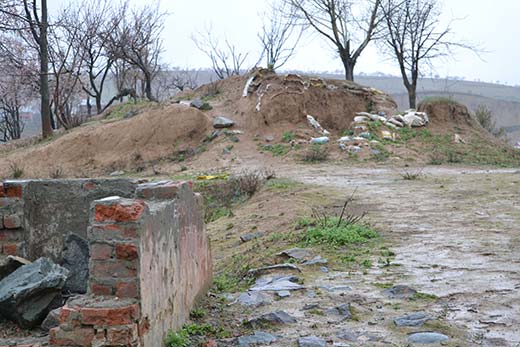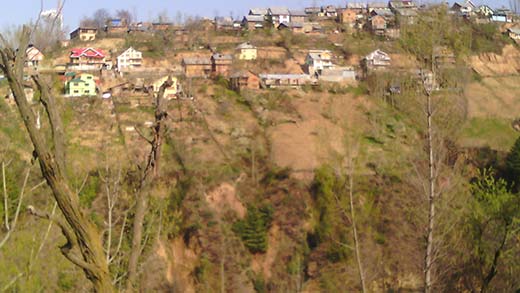After removal of dreaded Hanwari camp in Charar-i-Sharief life is slowly bouncing back to normal. But can the freed landscape help in healing painful scars left behind over the years. Irfan Rashid reports

For 8-year-old Saba a vast open space at the end of Hanwari Mohallah in Charar-i-Sharief evokes no memories except the pleasant ones. Every day, almost like a routine, Saba along with her few friends, from a nearby school, visit this ground to practice their cricketing skills.
The ground, which overlooks almost entire Charar-i-Sharief town, is dotted with the remains of bunkers and impressions of a past that refuses to fade from the memories of people living nearby.
Saba was just 4-year-old when the bunkers housing CRPF men were removed in 2011. Her memory of the bunkers is limited to her occasional visits with her brother Tawseef, and getting toffees’ by men in uniform.
But for 22-year-old Tawseef, the calmness that Saba relates with this ground is hard earned.
Till 1995, at the peak of militancy, unlike other major towns in Valley, Charar-i-Sharief had just one army camp. The camp was stationed on the highest peak in town called Noful Teng.
But after the siege of Charar-e-Sharief in 1995 and the successful escape of Pakistani militant commander Major Mast Gul, this small shrine town changed quite fast. The siege ended in a major inferno that left most of the town gutted.
After 1995 inferno army occupied many strategic locations in and around Charar-e-Sharief to keep a close watch on people living in the town. And one of the camps that came up post 1995 inferno was dreaded Hanwari camp.
Hanwari was chosen for its strategic location. It was on top of a hillock overlooked entire town with ravine on three sides. “The bunkers were constructed in such a way that major entry points were under army’s watchful eyes,” says Tawseef who lived adjacent to the camp’s main entrance.
Tawseef was one of the lucky few who had access inside the camp. “I used to help army men procure their daily need items against a commission. They (army men) would simply call me from the gates to get things from the market,” says Tawseef.
Tawseef’s proximity with the camp was beneficial for him as he was happy to at least add to his father’s meagre income. Tawseef’s father then was a small time labourer who earned his living by making Kangris (traditional earthen pots) for sale in the local market.
But the events of a particular winter night in 2010 changed Tawseef and his perception towards army men and the supposed camaraderie, forever.
One night a loud knock at the door woke Tawseef’s family. His father went outside to check who is at the door. “There were at least ten army men at the door. The moment my father opened the door they pounced on him and began kicking and beating him with gun butts,” recalls Tawseef. “
Only a couple of steps behind his father, Tawseef stood, shocked, unable to move. He could recognize almost all of them (army men). “They were the same guys who used to ask for favour and I thought were my friends,” says Tawseef.
Hearing cries of Tawseef’s father his friend Mushtaq, who was staying at their house that night, rushed out too. But before he could have done anything to save his friend someone hit him on the nose and dragged him back in. “He (Mushtaq Uncle) was bleeding badly. His nose was broken,” recalls Tawseef. “I tried to follow him but one of army men caught hold of me. I didn’t resist.”
Then there was silence. “I felt hopeless, helpless and terribly alone. It continued for almost two hours,” says Tawseef. “Then they left and our lawn was filled with neighbours. Papa put on a brave face as he was being removed from the house, carried by three men.”

Tawseef’s father never talked about what happened that night with anybody.
After the camp was removed in 2011 and a sense of security prevailed over the area, Tawseef’s father finally revealed the happenings of that night. “I was beaten. They told me that a militant has passed through our compound,” says Tawseef’s father. “We were tortured for an incident over which we had no control!”
After that incident Tawseef restricted his contact with the army men stationed at the camp near his house. “I always knew that they cannot be our friends. But a poor man like me has no option when it comes to helping ones family,” says Tawseef.
During his long visits to the camp Tawseef recalls how Kashmiris working in the army would try to lure him to act as informer. “I might have fallen in their trap but a friendly army man from Kolkata advised me against such a foolish step,” recalls Tawseef.
That friendly army man had told Tawseef that an informer no doubt earns good money but always ends up dead. “He told me ‘you will get yourself killed in between’,” says Tawseef.
One incident that is still fresh in Tawseef’s memory dates back to 2004. There has been a battalion change in the camp, remembers Tawseef.
“One night I came home late with my family after spending the day at a picnic spot. When we reached near our gate army men guarding the camp pointed their weapons at us,” recalls Tawseef. “They were about to shoot when I shouted: I live here, I live here. Please don’t shoot us.”
But the army men, probably drunk at that hour, instead started abusing Tawseef and his family, he recalls. “They shouted, ‘Yeh desh hamara hai saley…shaam ko jaldi andar bethna chahye’ (This is our country. You better get home early).”
Trigger Happiness
One of the painful memories attached with Hanwari camp that people of Charar-e-Sharief refuse to forget and forgive are from summer 2010 civil unrest.
It was at the peak of 2010 unrest that protests started taking place in Charar-e-Sharief town. “We saw the worst of that camp in 2010 when they killed Danish and injured Shakeel,” says Tawseef.
Danish was studying in 7th standard when he was killed by CRPF men stationed at the Hanwari camp.
Danish’s friend Faisal, who was with him that day, recalls events leading to his death vividly. “We were together that day. Our teacher had assigned us homework for which Danish was supposed to visit our home,” recalls Faisal.
On his way to Faisal’s house Danish met a small crowd of protestors heading towards the main town. When protestors reached near Hanwari camp, without any warning or provocation CRPF men fired shots towards people, recalls Tawseef. The first shot hit Danish directly and he fell down on the ground. “He was not dead. But before people could have helped him CRPF men came out of their camp and dragged him inside,” recalls Tawseef. “One of them (CRPF men) begins kicking him with his hard leather boots. Another one started beating him with the gun butts. He was bleeding all the time because of the bullet wound,” recalls one eyewitness.
“All the time Danish kept his notebook clutched closed to his chest,” says the eyewitness.
But that was not the end of nightmare for people who had assembled to protest against the killing of a teenager by CRPF men in Srinagar a day before. The next shower of bullets hit Shakeel, a local, who fell on the ground instantly.
“When bullet hit me in the abdomen I thought I was dead. But when CRPF men came close to drag me inside like they did with Danish, I pretended to be dead,” recalls Shakeel.
Eyewitnesses claim no one was allowed to lift Danish and Shakeel for more than one hour despite bleeding profusely. “It was only after ambulance arrived that they allowed us to move Danish and Shakeel,” says an eyewitness. Danish was declared brought dead by the doctors. Shakeel was shifted to Srinagar for treatment.
While Shakeel struggles to fight his nightmares, Danish’s mother still waits for her son. “She doesn’t cry as she still believes that Danish will be back someday,” says Faisal. “She would say: Su chu gomut dostas nish keam tarnea (He has gone to his friend’s house to complete his homework).
But as the time passed like other mothers of slain victims in Kashmir Danish’s mother too was made to understand that her son is dead.
A Dangerous Walk
The land on which Hanwari camp was built belonged to one local. He had leased around 20 kanals of land to the army after 1995 inferno.
It is said that the owner was initially reluctant to lease the land to army, but was finally coerced in.
After the camp was set up army started wiring land adjacent to the leased plot as well. “They systematically managed to block the only access route to adjacent field,” says Suhail Ahmad, 22, a student who lives near to the camp.
And those who still had access to their fields by taking de-tour of the camp would face regular harassment by army men stationed at the bunkers overlooking the road. “This road was the only way to reach orchards in Hapat Naad and Rakhaai,” says Suhail.
Before the present muddy road for vehicles, only horses were used to carry boxes of fruits from orchards to the main town. “They used to stop horses and would even open apple boxes,” remembers Ghulam Mohammad, 45, a horse carrier.
It was very hostile for people who would go to their fields for labour. “They would throw stones at people travelling on this road from above. I had been hit by a stone once myself,” says Amina, who hails from nearby Trajbal locality.
After the Hanwari camp came into existence movement of womenfolk to their fields got restricted. “A female could never pass that area alone unless accompanied by a male. Initially when women used to visit their farms through that area they realized that army men would whistle, shout and even harass them by passing lewd comments,” recalls Amina.
“Last time when I passed that camp area alone was in my 2nd class. One day, when my mother was on her way to our orchid, she was called out by army men to come inside the camp,” says Neelofar, who is now pursuing her final year of graduation from government degree college, Charar-i-Sharief.
But with Hanwari camp gone and the only remnants of a painful past reflected by a few sandbags that once were bunkers, children like Saba spend their time playing hide-and-seek inside the ground. On every evening, young boys would assemble inside the bunkers and chat for hours together. And for obese women this ground is a jogger’s park!















